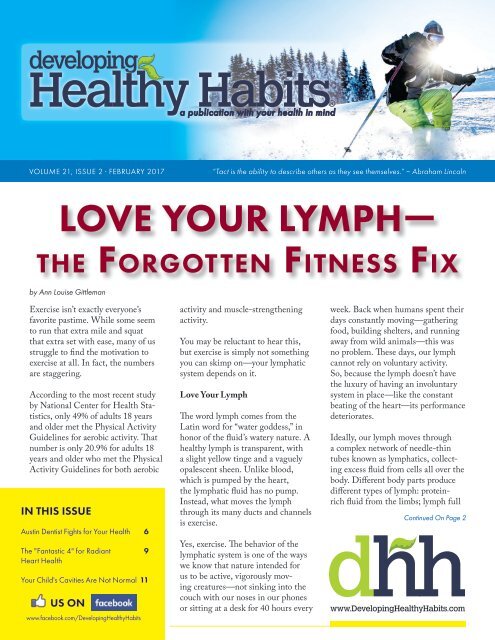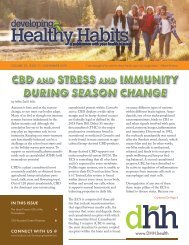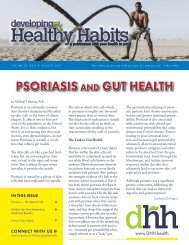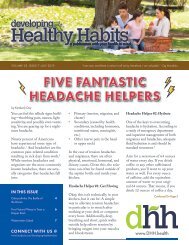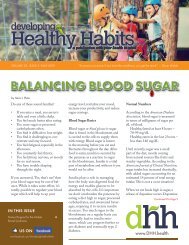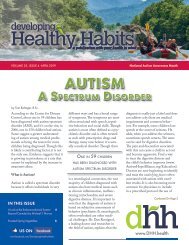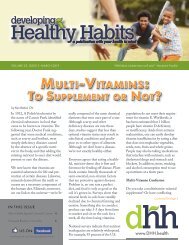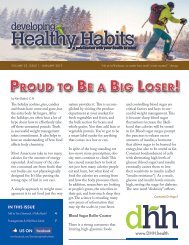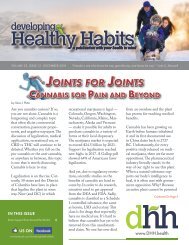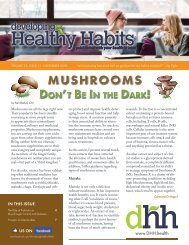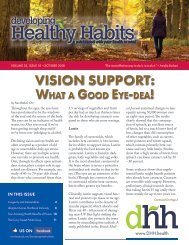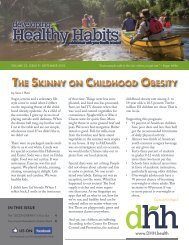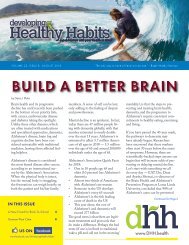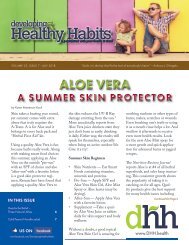February 2017
Create successful ePaper yourself
Turn your PDF publications into a flip-book with our unique Google optimized e-Paper software.
VOLUME 21, ISSUE 2 · FEBRUARY <strong>2017</strong><br />
“Tact is the ability to describe others as they see themselves.” ~ Abraham Lincoln<br />
LOVE YOUR LYMPH—<br />
the Forgotten Fitness Fix<br />
by Ann Louise Gittleman<br />
Exercise isn’t exactly everyone’s<br />
favorite pastime. While some seem<br />
to run that extra mile and squat<br />
that extra set with ease, many of us<br />
struggle to find the motivation to<br />
exercise at all. In fact, the numbers<br />
are staggering.<br />
According to the most recent study<br />
by National Center for Health Statistics,<br />
only 49% of adults 18 years<br />
and older met the Physical Activity<br />
Guidelines for aerobic activity. That<br />
number is only 20.9% for adults 18<br />
years and older who met the Physical<br />
Activity Guidelines for both aerobic<br />
IN THIS ISSUE<br />
Austin Dentist Fights for Your Health<br />
The "Fantastic 4" for Radiant<br />
Heart Health<br />
Your Child's Cavities Are Not Normal 11<br />
US ON<br />
www.facebook.com/DevelopingHealthyHabits<br />
6<br />
9<br />
activity and muscle-strengthening<br />
activity.<br />
You may be reluctant to hear this,<br />
but exercise is simply not something<br />
you can skimp on—your lymphatic<br />
system depends on it.<br />
Love Your Lymph<br />
The word lymph comes from the<br />
Latin word for “water goddess,” in<br />
honor of the fluid’s watery nature. A<br />
healthy lymph is transparent, with<br />
a slight yellow tinge and a vaguely<br />
opalescent sheen. Unlike blood,<br />
which is pumped by the heart,<br />
the lymphatic fluid has no pump.<br />
Instead, what moves the lymph<br />
through its many ducts and channels<br />
is exercise.<br />
Yes, exercise. The behavior of the<br />
lymphatic system is one of the ways<br />
we know that nature intended for<br />
us to be active, vigorously moving<br />
creatures—not sinking into the<br />
couch with our noses in our phones<br />
or sitting at a desk for 40 hours every<br />
week. Back when humans spent their<br />
days constantly moving—gathering<br />
food, building shelters, and running<br />
away from wild animals—this was<br />
no problem. These days, our lymph<br />
cannot rely on voluntary activity.<br />
So, because the lymph doesn’t have<br />
the luxury of having an involuntary<br />
system in place—like the constant<br />
beating of the heart—its performance<br />
deteriorates.<br />
Ideally, our lymph moves through<br />
a complex network of needle-thin<br />
tubes known as lymphatics, collecting<br />
excess fluid from cells all over the<br />
body. Different body parts produce<br />
different types of lymph: proteinrich<br />
fluid from the limbs; lymph full<br />
Continued On Page 2<br />
www.DevelopingHealthyHabits.com
Developing Healthy Habits<br />
Published by:<br />
Developing Healthy Habits, LLC.<br />
3275 S. John Young Parkway, Suite 152<br />
Kissimmee, FL 34746<br />
1-800-713-2802<br />
www.DevelopingHealthyHabits.com<br />
Executive Editor<br />
Mark A. Carroll<br />
Mark@DevelopingHealthyHabits.com<br />
Managing Editor<br />
Sandra Michalski<br />
Marketing/Editor<br />
Nicholas A. Carroll<br />
Design<br />
NXS Designs<br />
JAM Graphics Design<br />
Contributors<br />
Griffin Cole<br />
Ann Louise Gittleman<br />
Mark J. Kaylor<br />
To subscribe visit:<br />
www.DevelopingHealthyHabits.com<br />
For content contribution contact:<br />
Sandra@DevelopingHealthyHabits.com<br />
For advertising inquires contact:<br />
Nick@DevelopingHealthyHabits.com<br />
Mission Statement<br />
“Our mission is to continually provide<br />
a well written and clearly presented newsletter<br />
that is devoted to empowering individuals<br />
to make educated decisions relating to their<br />
health and wellness.”<br />
The statements and products in this newsletter<br />
have not been evaluated by the Food and Drug<br />
Administration and are not intended to diagnose,<br />
treat, cure or prevent any disease.<br />
LOVE YOUR LYMPH — Continued from Page 1<br />
of white blood cells from the bone<br />
marrow, thymus, and spleen; and,<br />
most important for our purposes,<br />
high-fat lymph from our intestines.<br />
Fat is the only food element that<br />
moves through the lymphatic system.<br />
The proteins and carbohydrates<br />
that we ingest go right from the<br />
intestines into the bloodstream, but<br />
the intestinal lymphatics draw fat<br />
into the lymphatic system before it<br />
reaches the blood.<br />
So, what happens when the lymph<br />
isn’t flowing properly? First, the<br />
excess fluid that isn’t draining from<br />
our tissues causes them to swell.<br />
These bloated, water-logged tissues<br />
can add up to 10 or 15 pounds to<br />
your weight, and cause you to swell<br />
two extra pant sizes.<br />
Also, poor lymphatic circulation<br />
means that the nutrients we ingest<br />
don’t get properly absorbed. Picture<br />
a single body cell as it is bathed in<br />
nourishing fluid from your bloodstream.<br />
This little cell is fed by the<br />
water, proteins, and other molecules<br />
that leak from the capillaries—tiny<br />
arteries that drain into body tissues.<br />
But if the tissues are already full of<br />
liquid, they can’t efficiently absorb<br />
those nutrients. It’s like having a<br />
backed-up drain—no more water<br />
can get into the sink because it’s<br />
already full. The function of the<br />
lymphatic system is to continually<br />
drain excess liquid, so that new<br />
blood, with its new nutrients, has<br />
room to flow into the cells.<br />
Obviously, if the new blood has<br />
trouble reaching your cells, you<br />
won’t absorb its nutrients very<br />
efficiently, and so you’ll need to<br />
eat more to obtain the same nutritional<br />
benefits. In fact, you might be<br />
relatively malnourished, despite the<br />
high-quality food you are consuming.<br />
By assisting the lymphatic system<br />
to drain fluids more effectively,<br />
it enables each cell in your body to<br />
absorb available nutrients, making<br />
the best use possible of every calorie<br />
you consume.<br />
Create the Habit<br />
I hope by now you are convinced of<br />
how important it is to get moving!<br />
If you’re thinking “I know that I<br />
need to exercise, but it’s impossible<br />
for me to find the motivation to do<br />
it,” stop right there. You can find<br />
the motivation and once you do, if<br />
you’re patient and diligent, it will<br />
become a habit. These are my best<br />
tips to finesse fitness into your life.<br />
Find the Right Niche<br />
Don’t limit yourself to one type of<br />
exercise or force yourself to do one<br />
that doesn’t suit you. There are avid<br />
runners, passionate yogis, strong<br />
weight lifters, and energized power<br />
walkers. Experiment with trying<br />
different classes, different trainers,<br />
and different styles of exercise until<br />
you find what’s right for you. It may<br />
even come as a surprise how much<br />
you end up loving a class you never<br />
thought you’d take.<br />
Set Small Goals<br />
It’s great to set long term goals, but<br />
when that becomes your focus, you<br />
can easily become overwhelmed<br />
and lose sight that you are, in fact,<br />
making steady progress to those<br />
goals. Each week, set your intentions—whether<br />
it’s to run a little<br />
farther, lift a little more, or simply<br />
get moving doing anything a certain<br />
number of days—and at the end of<br />
the week evaluate how these small<br />
goals are moving you towards the<br />
bigger ones. You’ll feel proud and<br />
accomplished at each check in!<br />
Strategically Determine Your Timing<br />
It’s ideal to exercise with the sunrise,<br />
but exercising at any time is<br />
Continued On Page 4<br />
2 <strong>February</strong> <strong>2017</strong> • www.DevelopingHealthyHabits.com
Good tasting.<br />
Good for you.<br />
Pure and simple.<br />
We all need omega-3s to stay healthy. But most of us don’t get enough.<br />
Fish oil is a great source of these essential fats. So get the omega-3s you<br />
need from the #1 fish oil in the U.S.†<br />
† Based on SPINS Scan Data
LOVE YOUR LYMPH — Continued from Page 2<br />
far better than not exercising at all.<br />
If you seem to try and fail to rise<br />
early, but it’s much easier to motivate<br />
yourself to head to a fitness class after<br />
work—do that. You can also always<br />
split your time. Perhaps you can set<br />
your alarm 15 minutes early for a<br />
morning walk and work in another<br />
15-30 minutes later in the day. Many<br />
also find great success with a mid-day<br />
workout during their lunch break.<br />
Work with your schedule, not against<br />
it.<br />
Do Your Best—For that Day<br />
There are countless factors that come<br />
into play each day that affect your<br />
mood, your energy, and your overall<br />
motivation. Each day, work to the<br />
best of your ability for that day and<br />
don’t berate yourself when one day<br />
is different from another. It’s okay if<br />
on Tuesday you beat a personal best,<br />
but on Thursday you are simply happy<br />
that you completed a short walk.<br />
Find a Friend<br />
Accountability partners make all the<br />
difference for many. When you know<br />
that your friend is joining you for<br />
that morning jog or waiting in their<br />
car for you at the gym, it ignites an<br />
extra spark to not let yourself—or<br />
your friend—down. Plus, during your<br />
workout, you have a built-in motivator<br />
and a great person to chat with<br />
while resting between exercises.<br />
We may not be hunters and gatherers<br />
anymore, but there are still plenty<br />
of ways in our modern world to get<br />
moving and keep your lymphatic system<br />
in tip-top shape. For even more<br />
lymph-loving tips and tricks, pick<br />
up a copy of my New Fat Flush Plan.<br />
This time-tested lifestyle program is<br />
unlike any other diet or fitness book,<br />
targeting the lymph and resetting<br />
your entire body for optimum function<br />
and wellness.<br />
Author’s<br />
Bio:<br />
Ann Louise Gittleman, PhD, CNS is<br />
an award-winning author and highly<br />
respected health pioneer who has spent<br />
her career continually breaking ground in<br />
traditional and holistic health. Her over<br />
30 published books include New York<br />
Times bestsellers The Fat Flush Plan and<br />
Before the Change. A Columbia University<br />
graduate, Gittleman has been recognized<br />
as one of the top ten nutritionists in<br />
the country by Self magazine and has<br />
received the American Medical Writers<br />
Association award for excellence.<br />
www.annlouise.com<br />
Blood Pressure Factors <br />
Regulation of blood pressure in the body is constantly monitored through a<br />
“negative feedback loop”.<br />
Supports the cardiovascular system:<br />
Hawthorn – cardiovascular support. Taurine – found in relatively high levels in the heart muscles and has<br />
neurotransmitter properties for the nervous system. Involved in cell volume regulation in the nervous system.<br />
Magnesium – a mineral relaxant for arterial smooth muscle, works with calcium. As an electrolyte it is<br />
needed by nerve and muscle cells including the heart. Cayenne – an herbal smooth muscle relaxant.<br />
Apple pectin – soluble fiber. Manganese – The antioxidant enzyme system Superoxide Dismutase (SOD)<br />
located in mitochondrial membranes uses manganese at its active site.<br />
Supports the nervous system:<br />
Calcium – A mineral important for neuromuscular excitability and the transmission of nerve impulses.<br />
Magnesium – Vitamin B6 – nerve nutrient, acts as a co-enzyme for the synthesis of several<br />
neurotransmitters including serotonin. Potassium – electrolyte for proper nerve action and communication.<br />
Valerian – relaxant. Hops – relaxant that does not cause drowsiness during the day; nervine.<br />
Supports fluid balancing:<br />
Vitamin B6 – helps the body to maintain the balance between sodium and potassium, and to regulate<br />
the body’s fluids. Potassium – balances sodium levels in tissues by entering cells and displacing sodium.<br />
Celery – traditional herbal nerve tonic.<br />
FAMILY OWNED • KOSHER<br />
VEGAN/VEGETARIAN<br />
Additional<br />
Taurine – An amino acid known to affect certain biological functions, including cardiac.<br />
Vitamin D for proper Calcium metabolism and absorption.<br />
michaelshealth.com<br />
tried & truthful<br />
4 <strong>February</strong> <strong>2017</strong> • www.DevelopingHealthyHabits.com
CONGESTION?<br />
GO WASH<br />
YOUR NOSE<br />
#<br />
Use Xlear saline nasal spray with natural Xylitol daily<br />
to clean your nose of allergens, pollutants, and germs.<br />
The saline washes, while the Xylitol coats and protects,<br />
so your nose will stay clear with Xlear.<br />
Find out more at xlear.com<br />
www.DevelopingHealthyHabits.com • January <strong>2017</strong> 13
AUSTIN DENTIST<br />
FIGHTS FOR<br />
YOUR HEALTH<br />
by Griffin Cole, DDS NMD IBDM FIAOMT<br />
“We have a motion for the city<br />
council to evaluate our fluoridation<br />
program and discuss the possibility<br />
of cessation of such program….<br />
do we have a second?” Nothing. Not<br />
one of the other council members on<br />
the dais was swayed from her initial<br />
“misinformed” notions that fluoride is<br />
good for Austinites to ingest. Councilman<br />
Don Zimmerman’s efforts,<br />
backed by sound scientific information,<br />
were ended before they even<br />
began.<br />
In August of 2015, Councilman<br />
Zimmerman became the first sitting<br />
Austin councilman to hold<br />
two hearings to adopt a resolution<br />
to end fluoridation. Justin Arman,<br />
activist and co-owner of a local<br />
brand called My Magic Mud (who<br />
produces natural oral care products)<br />
and I, were asked to help in<br />
this process by drafting the resolution<br />
that would finally end this<br />
unnecessary and dangerous policy<br />
that has been forced on Austinites<br />
since 1971. We were able to clearly<br />
show that over the last ten years of<br />
research, scientific evidence proves<br />
that ingesting fluoride has little to<br />
no effect on decay prevention and<br />
that despite the CDC’s promotion<br />
of fluoridation, to date; there have<br />
never been any rigorous, randomized<br />
clinical trials to prove fluoride’s<br />
effectiveness in water supplies.<br />
You may be asking, “But isn’t fluoride<br />
good for my teeth?”<br />
Here are some facts about fluoride:<br />
Fluoride is not an essential nutrient.<br />
The National Academy of<br />
Sciences has confirmed this and as<br />
early as 1963, the Food and Drug<br />
Administration stated publicly<br />
that fluoride is a drug, not a nutrient.<br />
By 1975, the FDA stated that<br />
fluoride is, in fact, an unapproved<br />
drug whose applications had been<br />
rejected because, “…no substantial<br />
evidence of drug effectiveness<br />
as prescribed, recommended, or<br />
suggested in its labeling.” It is<br />
not required for any physiological<br />
process in the human body, nor will<br />
anyone suffer if they lack fluoride.<br />
The overrated claim that fluoride<br />
prevents tooth decay is unfounded.<br />
There is certainly no difference<br />
between the fluoride content of<br />
healthy and decayed teeth.<br />
In actuality, fluoride contributes to<br />
a gamut of disease processes. Fluoride<br />
is a major endocrine disruptor,<br />
decreasing thyroid function particularly<br />
in people who are iodine<br />
deficient. It also interferes with the<br />
proper formation of collagen, which<br />
is the most important structural<br />
protein in the body. Additionally,<br />
fluoride is known to harm enzymes<br />
by inhibiting some and artificially<br />
stimulating others. The danger of<br />
excess fluoride is also known to<br />
result in dental fluorosis, a condition<br />
in which the teeth become<br />
discolored and brittle, as the photo<br />
shows.<br />
Austin city council members continue<br />
to blindly accept the CDC’s<br />
recommendations for fluoride with<br />
no regard for current science, clearly<br />
showing that it does not do its<br />
intended function of decay prevention.<br />
Though we temporarily lost<br />
our fight in Austin, the city of San<br />
Marcos, with the assistance of many<br />
of our Fluoride-Free Austin members<br />
including Justin Arman (My<br />
Magic Mud’s company headquarters,<br />
located just south of Austin,<br />
became the offices of Fluoride-Free<br />
San Marcos Coalition), was able to<br />
successfully end their long-standing<br />
fluoridation program just a few<br />
months later.<br />
Continued On Page 8<br />
6 <strong>February</strong> <strong>2017</strong> • www.DevelopingHealthyHabits.com
www.DevelopingHealthyHabits.com • <strong>February</strong> 2016 7<br />
Advertisement
AUSTIN DENTIST — Continued from Page 6<br />
Fortunately, there are dentists and<br />
other medical practitioners like<br />
myself, who speak out and fight<br />
against this outdated and unfounded<br />
practice of medicating our water<br />
supply. It all starts with grassroots<br />
efforts. Joining a local safe water<br />
organization, calling or writing your<br />
city council members, organizing<br />
public information meetings and<br />
recruiting others to join your efforts<br />
are the most productive ways to get<br />
the process moving. Many communities<br />
like San Marcos have been<br />
successful in blocking or removing<br />
the fluoride from the water supplies<br />
through organized grassroots efforts.<br />
If you’d like more information<br />
on fluoride and community water<br />
fluoridation, visit griffincole.com or<br />
via email griffincole@yahoo.com.<br />
Author’s Bio:<br />
Dr. Cole, a graduate<br />
of the University<br />
of Texas<br />
Health Science Center in San Antonio,<br />
has been practicing biological<br />
dentistry (mercury-safe, fluoride-free)<br />
since 1993. He achieved Fellowship<br />
status in the International Academy<br />
of Oral Medicine and Toxicology<br />
in 2008, authored the Academy’s<br />
Fluoridation brochure and Scientific<br />
Review on Ozone use in Root Canal<br />
Therapy, and currently serves as the<br />
Academy President.<br />
He acquired certification in oxygenozone<br />
therapy in 2006 becoming the<br />
first dentist in Texas to accomplish<br />
this. He also achieved his Board Certification<br />
in Naturopathic Medicine<br />
along with a degree in Integrative<br />
Biological Dental Medicine in 2010.<br />
He has been published in numerous<br />
national dental publications including<br />
Contemporary Esthetics and Dentistry<br />
Today for both his cosmetic work and<br />
his commentary on dental issues. His<br />
most recent publication – “Treatment<br />
of Bisphosphonate-Related Osteonecrosis<br />
of the Jaw With Oxygen-<br />
Ozone Therapy” published in May,<br />
2013 in the Journal of Implant and<br />
Advanced Clinical Dentistry, is the<br />
first documented case report showing<br />
complete resolution of an osteonecrotic<br />
lesion utilizing only ozone<br />
therapy.<br />
Dr. Cole has also been featured on<br />
numerous television and radio news<br />
spots including World News Tonight<br />
with Diane Sawyer for his expertise<br />
on water fluoridation and dental<br />
mercury issues.<br />
Find us<br />
on Facebook<br />
8 <strong>February</strong> <strong>2017</strong> • www.DevelopingHealthyHabits.com
The "Fantastic 4"<br />
for RADIANT HEART HEALTH<br />
by Mark J. Kaylor<br />
Let’s get right to it — heart disease is<br />
largely preventable and reversible.<br />
Heart disease is the number one<br />
killer in America, for both men and<br />
women, and has been for some time.<br />
While the stats have improved some<br />
recently, almost 400,000 people die<br />
every year from coronary heart disease<br />
(CHD). The creation of arterial<br />
lesions and plaque buildup occurs<br />
over decades* and is a fundamental<br />
contributor to an array of cardiovascular<br />
issues. The good news is that<br />
“heart disease is largely preventable<br />
and reversible.” Here are suggestions<br />
from four key categories that are<br />
likely to have the biggest, quickest<br />
and, hopefully, best impact.<br />
In the Beginning — Diet<br />
If there was a germ that was<br />
killing one American every 83<br />
seconds, we would undoubtedly<br />
have declared war on the bug and<br />
eliminated it. However, this is<br />
precisely what is happening with<br />
the highly preventable coronary<br />
heart disease and yet the deaths<br />
continue to accrue. The difficulty<br />
is that the primary answer to this<br />
epidemic requires us to change our<br />
diet and we all know how resistant<br />
we can be to that. On top of<br />
this, you have huge financially-vested<br />
interests that want to keep you eating<br />
the S.A.D. (Standard American Diet)<br />
way. Let’s change this today and make<br />
this the beginning of the end for<br />
CHD by changing our eating habits.<br />
There are thousands of diets out there,<br />
but there is one that stands out in the<br />
research that is actually quite simple,<br />
a plant-based diet. It’s as simple as<br />
that; eat a whole food, plant-based<br />
diet. Numerous studies confirm that<br />
this simple yet effective approach<br />
can not only prevent cardiovascular<br />
disease (CVD), but reverse and repair<br />
the damage from it. A whole foods<br />
plant-based diet reduces our risk for<br />
CVD, reduces inflammatory markers<br />
and free radicals, improves endothelial<br />
(lining of the arteries) dysfunction<br />
and probably most importantly of<br />
all — reduces our risk of dying from<br />
CVD. One food group of special note<br />
is nuts (especially walnuts). Nuts are<br />
research supported to reduce risk for<br />
CVD, improve endothelial function<br />
and lower cholesterol.<br />
One big step is to eliminate, as much<br />
as possible, all the refined carbohydrates<br />
and sugars that make their way<br />
into our diet. How impactful is eating<br />
refined sugars? Consuming 25% of<br />
your calories from sugar almost triples<br />
your chance of developing CVD.<br />
While we are cutting back on our<br />
sugar intake, we can use things like<br />
the Maitake SX-Fraction (to lower<br />
blood sugar and insulin levels), chromium,<br />
and PGX fiber.<br />
All-Star Heart Health Tonics<br />
There are two natural remedies that<br />
stand out for supporting overall cardiovascular<br />
health in what I consider<br />
a holistic manner, the traditional<br />
heart herbal Hawthorn and Reishi.<br />
Hawthorn — long used in Europe<br />
for all things cardiovascular, it has<br />
been shown to lower blood pressure<br />
and cholesterol, increase oxygen and<br />
blood supply to the heart, improve<br />
heart energy production and<br />
strengthen the contraction of the<br />
heart muscle.<br />
Reishi — shown to lower blood<br />
pressure, triglycerides and cholesterol,<br />
while reducing systemic<br />
inflammation and free radical<br />
damage (preventing oxidation<br />
by macrophage — a key step in<br />
the build up of plaque), lessen<br />
myocardial collagen cross-linking<br />
and enhance heart mitochondrial<br />
activity. It has also demonstrated<br />
heart-protecting actions against<br />
several toxins including alcohol<br />
and Adriamycin. On the holistic<br />
side, it supports liver health and<br />
function. The liver is where cholesterol<br />
is synthesized and is responsible<br />
for filtering and replenishing the<br />
blood, all the while helping the body<br />
to respond to stress in a healthier<br />
manner.<br />
Continued On Page 10<br />
www.DevelopingHealthyHabits.com • January <strong>February</strong> 2016 <strong>2017</strong> 13 9
RADIANT HEART HEALTH — Continued from Page 9<br />
Key Remedies for Heart Health<br />
Ensuring that our cardiovascular system<br />
is receiving all the nourishment<br />
it needs is obviously a starting point,<br />
but there are a few nutrients that are<br />
especially impactful.<br />
Magnesium — diets deficient in<br />
Magnesium are associated with atherosclerosis,<br />
heart attacks and CVD.<br />
Unfortunately, it is a nutrient most<br />
of us are deficient in. Magnesium is<br />
useful for prevention and treating<br />
CVD and plays a key role in myocardial<br />
energy production. It also inhibits<br />
platelet aggregation and promotes<br />
vasodilation, while supporting endothelial<br />
function.<br />
CoQ10 and Carnitine — These two<br />
synergistic nutrients are essential.<br />
CoQ10 deficiency is associated with<br />
CVD and plays a key role in the<br />
mitochondrial production of energy.<br />
Keep in mind the heart is a muscle<br />
and is absolutely dependent upon<br />
this process. It has shown promise<br />
for cardiomyopathy, congestive heart<br />
failure, angina, arrhythmias and<br />
hypertension. Carnitine also plays a<br />
key role in myocardial metabolism. It<br />
is important in energy production by<br />
transporting fatty acids into the mitochondria<br />
to be burned as fuel. Studies<br />
suggest potential use in benefiting<br />
lack of blood flow, decreasing mortality<br />
for heart attack sufferers, heart<br />
failure and angina.<br />
Let it Shine<br />
AloeGoldAdwTablets8_16_16_Layout 1 8/16/16 2:05 PM Page 1<br />
Healthy Digestion<br />
AloeGold<br />
Taste & Feel the Difference<br />
WHOLE LEAF ALOE VERA<br />
JUICE CONCENTRATE<br />
Today’s fast-paced world demands a healthy<br />
digestive pathway to feel ones best!<br />
• Tastes Delicious (flavors) & Works Fast.<br />
• Best Buy for Optimum Body Wellness.<br />
• ORGANIC, CONCENTRATED Juice/Tablets.<br />
Great for Kids, Adults, Athletes<br />
plus gluten Free!<br />
Since 1991 • Satisfaction Guaranteed!<br />
1-800-414-ALOE • www.aloelife.com<br />
Traditional Chinese Medicine refers<br />
to our emotional/spiritual center of<br />
the body as Shen, located, of course,<br />
in the heart. Healthy Shen is related<br />
to not just emotional health, but radiant<br />
health. My top Shen tonic is the<br />
aforementioned Reishi mushroom.<br />
Not only does Reishi benefit your<br />
physical heart, it also benefits your<br />
emotional one as well, bringing balance<br />
to the mind-body-spirit.<br />
Here is an effective, yet simple Shen<br />
breathing technique to support your<br />
heart and overall health. Begin by<br />
breathing from your diaphragm saying<br />
the word “peace” in your head,<br />
pausing for a moment to let your<br />
heart fill with the peace energy, then<br />
exhale slowly thinking “love” allowing<br />
this energy to radiate throughout your<br />
whole body. Shen health is not to be<br />
overlooked. It has become very clear<br />
in recent research that our emotions<br />
are intimately tied and connected to<br />
our health, especially our heart health.<br />
Romantic Heart Help<br />
One “heart” area we seem to need<br />
help with today is in the romance<br />
and ‘bedroom’ areas. Thankfully, there<br />
is a long-used ‘aphrodisiac’ tonic to<br />
help, Cordyceps. It is one of the few<br />
clinically-confirmed natural aids for<br />
libido and hypo-sexuality for both<br />
men and women. Cordyceps has been<br />
shown to improve sex drive, virility<br />
and sexual function. It also brings<br />
a myriad of heart benefits as well,<br />
including improving blood flow to<br />
the heart, preventing platelet aggregation,<br />
anti-atherosclerotic and vasodilation.<br />
Clinically, it has been used for<br />
maintaining oxygen levels in stroke<br />
victims and improving overall quality<br />
of life in patients suffering from<br />
chronic heart failure. Studies show<br />
promise for arrhythmias as well.<br />
The Time is Now<br />
It would be wise for us to continue to<br />
lay claim to the old adage that “love<br />
is the best medicine.” Not only is it<br />
healing in and of itself, we can take it<br />
a step further and expand it to caring<br />
and loving ourselves enough that we<br />
make the necessary changes to our<br />
diets and routines to prevent and<br />
reverse the scourge of cardiovascular<br />
disease. As I wrote in the opening<br />
paragraph, this is a condition that we<br />
can do much to prevent and reverse.<br />
All it takes is to start making the<br />
changes today, right now.<br />
*In fact, atherosclerosis was found to<br />
begin in children around the age of 10.<br />
Infants may also show signs of arterial<br />
issues depending upon the mother’s diet<br />
and health.<br />
Author’s Bio:<br />
Mark J. Kaylor has<br />
been exploring holistic<br />
health and healing<br />
for close to four decades. He is the<br />
founder and director of the not-for-profit<br />
Radiant Health Project. Mark welcomes<br />
your comments and questions and can be<br />
contacted at his website:<br />
www.RadiantHealthProject.com or on<br />
Facebook at<br />
www.facebook.com/RadiantHealthProject<br />
10 <strong>February</strong> <strong>2017</strong> • www.DevelopingHealthyHabits.com
Your Child’s Cavities<br />
Are Not Normal<br />
Myths and Misconceptions<br />
Forty-two percent of the children aged two to<br />
eleven get cavities in their primary teeth. Some<br />
people may think this statistic is normal.<br />
But tooth decay should never be a normal part<br />
of a child’s life.<br />
Many people blame genes for their tooth<br />
decay, but seldom is it genes alone that cause<br />
tooth decay. There is another mother-to-child<br />
transmission that helps determine a child’s oral<br />
health. For protection from infections, a baby is<br />
exposed to specific bacteria and antibodies when<br />
going through the birth canal, while breastfeeding,<br />
as well as through kissing and testing of food.<br />
This process is called maternal imprinting which<br />
is the transmission of the mother’s microbiome<br />
(communities of good and bad bacteria in the<br />
body) to the baby.<br />
An oral microbiome consisting of mostly<br />
good bacteria helps to keep the digestive system<br />
working properly and to keep the teeth and gums<br />
healthy. An oral microbiome infested with bad<br />
bacteria leads to digestive issues, cavities, gum<br />
disease, and a less-than-satisfying smile. If the<br />
mother has an unhealthy microbiome, so will the<br />
baby. The baby’s oral health starts developing<br />
from day one and by three months old has an<br />
established microbiome transferred directly from<br />
their mother.<br />
60<br />
50<br />
40<br />
30<br />
20<br />
10<br />
0<br />
Percentage of tooth decay in children’s baby teeth<br />
24.2%<br />
1988 - 1994 1999 - 2004<br />
2-5 years<br />
49.9%<br />
27.9%<br />
6-11 years<br />
51.2%<br />
Additionally, an unhealthy oral microbiome<br />
can develop if the child’s teeth are not brushed<br />
and kept clean and the diet is high in sugar.<br />
Fortunately, in recent years society has begun<br />
seeking out healthier options, turning to products<br />
like organic sugar. But when it comes to the<br />
mouth, the bacteria don’t care if the sugar is<br />
organic or not. They still metabolize it and<br />
produce cavity-causing acids. So even if you use<br />
organic sugar in your cooking or your child chews<br />
gum with organic sugar, he will still have cavities.<br />
Luckily you can help your child have a healthy<br />
oral microbiome now. There are easy things you<br />
can do to ensure healhty teeth and gums from<br />
an early age. Your wallet will be a little fuller<br />
without the dental procedures, your child will be<br />
free of pain with a gleaming smile, and you will<br />
be able to enjoy some peace of mind.<br />
Lisa Stillman, RDH, BS<br />
Lisa is an Education Manager<br />
for Xlear Inc. She teaches health<br />
professionals the general and<br />
dental health benefits of quality<br />
xylitol products and assists<br />
dental offices in incorporating<br />
xylitol into the dental hygiene<br />
protocol. Lisa has practiced<br />
dental hygiene in Maryland and<br />
Virginia and currently has a position specializing in<br />
Periodontics. Lisa has also developed an organization<br />
called “Dental Voice for Mental Health” that assists<br />
mental health care recipients in caring for their oral<br />
health through NAMI health fairs, speaking at mental<br />
health facilities and writing articles.<br />
Three Tips to Improve Your Child’s Oral Health:<br />
1. Bottle and Sippy Cups – Never allow<br />
your baby or toddler to go to bed with a bottle<br />
of milk. The milk will pool in the mouth, and<br />
the bacteria will feed on the sugars in the milk<br />
throughout the night. Also, don’t put milk or<br />
juice in sippy cups for your child to drink<br />
throughout the day. Repeated exposures to<br />
sugar help bacteria thrive. The only thing a<br />
child should drink from a sippy cup is water.<br />
2. Good Habits – Make sure your child<br />
develops strong habits of brushing from a<br />
very early age. Habits engrained from an<br />
early age are harder to break and will help in<br />
the future to maintain the essential morning<br />
and nightly routine. Many parents have found<br />
success using a xylitol gel with their babies to<br />
form this habit since kids like the sweet taste<br />
and think it is a treat.<br />
Advertisment<br />
3. Xylitol Products Throughout the Day<br />
Thousands of clinical studies show the<br />
efficacy of xylitol in improving oral health.<br />
The most important factor with xylitol is<br />
having consistent exposures throughout the<br />
day. Use xylitol toothpaste and mouthwash in<br />
the morning, xylitol gum or mints after each<br />
meal and xylitol toothpaste at night. Xylitol<br />
should be listed as a primary ingredient.<br />
www.DevelopingHealthyHabits.com • <strong>February</strong> <strong>2017</strong> 11


